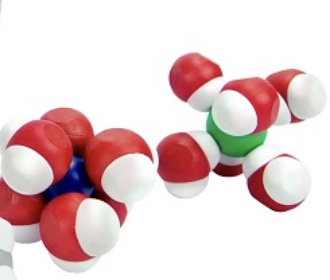This page is under construction. Web author: T. Greenbowe, University of Oregon
The following are recommended components for a module on teaching about dissolving ionic salts in water - dissolving - solution formation.
Summary: This page lists components for teachers to build a module on solution formation. The module consists of big ideas, learning objectives, pre-requisite knowledge, computer animations, hands-on calorimetry experiments to determine the change in enthalpy in various solutions (heat of dissolution), computer simulations to determine the change in enthalpy in various solutions, and a theoretical method determine the change in enthalpy in various solutions. This theoretical method involves lattice energy, heat of hydration and energy diagrams. The change in enthalpy value for each method is compared. Animations at the particle level and particle diagrams are used to represent (convey, visualization) what occurs at the particle level (ions and water molecules) when solids dissolve in water. Dynamic animations are used to represent how energy is transferred at the particle level. For exothermic dissolving processes the heat of hydration > lattice energy. The resultant solution gains energy which is manifested in more rapid movement of water molecules and ions - the resultant solution becomes warmer. For endothermic dissolving processes, lattice energy > heat of hydration. The resultant solution releases energy which is manifested in less movement of water molecules and ions - the resultant solution becomes cooler.
Essential Prior Student Learning
Calorimetry experiments: mixing hot and cold water, placing a hot piece of metal in cool water, reacting acids and bases to determine the change in enthalpy of neutralization.
Conductivity Experiments: classification of aqueous solutions as a strong electrolyte, weak electrolyte or nonelectrolyte based on the results of a conductivity experiment.
Modeling (representing) strong electrolytes, weak electrolytes or nonelectrolytes using particle diagrams.
Conductivity of electrolytes us due to the mass migration of cations and anions in the opposite direction in a conductivity apparatus.
Particle motion influence on thermometers. How does a thermometer measure temperature?
This is a necessary component of this instructional module. If one does do not understand how a thermometer works, one cannot understand thermochemistry concepts.
When the particles that compose an object begin to move faster and or vibrate more vigorously, the temperature of that object increases. Temperature is correlated with the average kinetic energy with which the particles move. The macroscopic property of matter - a thermometer reading - is tied to a particulate description of matter - the speed with which particles move and or at which particles vibrate.
There is a simple middle school activity about alcohol and mercury thermometers posted on the ACS AACT web site. This is a start.

There is a web site that partially explains the physics of thermometers.
There is an animation at the particle level of a digital thermometer. (coming soon)
Components
A. Video #1 sodium chloride dissolving in waterr. A short computer animation illustration how positive ions and negative ions in a solid ionic compound dissolve in water. This animation depicts a simple representation of sodium chloride solid dissolving in water at the "molecular level". Suggested uses: when introducing ionic solution formation and discussing the energies involved in solution formation. Note: this animation has low quality images.
B. Video #2 sodium chloride dissolving in waterr. Authors: Roy Tasker and colleagues. Molecular level representation: An animation of sodium chloride dissolving in water at the molecular level or particle level of representation is displayed. This animation is a simple model using an artistic representation or view of how particles behave during the dissolving process. This animation is not based on calculations using physical parameters. This animation is a simple representation of a complex process. Note: this animation has High quality images.
The animation starts with a view of the surface of the NaCl solid, represented as a lattice, the camera pauses to see the vibrating ions (thermal energy, kinetic energy). Then water molecules come tumbling down, hydrating the ions in a competitive ‘tug o’ war’ with the electrostatic forces attracting the ions together in the lattice (ionic bonds, potential energy). Several water molecules orient with their partial negative oxygen atoms toward a positive sodium ion, Na+. Several other water molecules orient with the partial positive ends of the hydrogen atoms toward the negative chloride ion, Cl-. Not shown, but implied - Compared to the original motion of the water molecules before dissolving occurs, the water molecules are moving slower after the solid dissolves.
Energy considerations: Ion-ion bonds in the NaCl lattice are broken (energy is added - an endothermic process). Ion-dipole intermolecular forces are formed between the ions and water molecules (energy is released, an exothermic process). It takes four or five water molecules surrounding a sodium ion, to transfer enough energy to break the ion-ion bonds in the NaCl lattice. It takes four or five water molecules surrounding a chloride ion, to transfer enough energy to break the ion-ion bonds in the NaCl lattice. Overall, the change in enthalpy for breaking the ionic bonds in the lattice is greater than the change in enthalpy given off when ion-dipole IMFs are formed. The change in enthalpy for the process of dissolving solid NaCl in water is endothermic. This dissolving process is called the heat of dissolution (often called the heat of solution).


C. 3D Model of NaCl solid and Water molecules with magnets
Investigate the strength of ionic bonds between Na+ and Cl- ions in an NaCl lattice, i.e. lattice energy. Explore how the positive sodium and negative chloride ions form electrostatic bonds. Investigate the polarity of water molecules. Feel the force of attraction between the partial negative end of the oxygen in the water molecule and a Na+ ion. Feel the force of attraction between the partial positive end of the hydrogens in the water molecule and a Cl- ion. Show ion-dipole intermolecular forces of attraction. Identify what causes the heat of hydration. Draw particle diagrams of all interactions.


Determination of the Energy Transfer Involved in Dissolving a Salt in Water
D. Determination of the Heat of Dissolution - Calorimetry Experiment
Students conduct a series of calorinetry experiments dissolving various ionic salts in water using a calorimeter. The solid salt and the water have the same initial temperature. First determine the heat energy exchanged by the resultant solution, qsoln. Students can measure the mass of the salt, the mass of the water, the initial temperature and final temperature of the resultant solution. The specific heat capacity of the solution is given. qsoln = m x c x ΔT. ΔT = Tfinal - Tinitial
Invoke the Law of Conservation of Energy to determine the heat energy exchanged by the dissolving process. qloss + qgain = 0 qsoln + qrxn = 0. qsoln + qdissolving process = 0
qsoln = - qdissolving process. qsoln will have a negatative value since ΔT is negative, Tfinal < Tinitial
qdissolving process will have a positive value.
Determine the change in enthalpy of the dissolving process, ΔHdissolution. ΔH will have a positive value since dissolving solid NaCl in water is an endothermic process.
Example. Experimental observations: The initial temperature of the solid sodium chloride and water are the same. Using a calorimeter, 10.0 g of solid sodium chloride dissolves in 50.0 g of water. The temperature of the resultant solution, NaCl(aq), is lower compared to the initial temperature of the water.
E. Calorimetry Computer Simulation is used to determine the heat energy exchanged in a variety of physical and chemical processes. For this activity - choose dissolving ionic salts in water. This computer simulation allows one to select the mass and initial temperature of various substance, mix the substances in a calorimeter, and record the final temperature. Use the simulation and select sodium chloride solid, NaCl(s) and water. Select the mass of each. Record the mass of each and the initial temperature of each.
Example. Experimental observations: The initial temperature of the solid ammonium nitrate and water are the same, 20°C. Using a calorimeter, 10.0 g of solid ammonium nitrate dissolves in 100.0 g of water. The final temperature of the resultant solution, NH4NO3(aq), is 13.35°C, which is lower compared to the initial temperature of the water. Determine the heat energy exchanged by the solution. Determine the heat energy exchanged by the dissolving process.


Determine the change in enthalpy of the dissolving process, ΔHdissolution
Choose view the molecular level representation. Click-on start. A brief computer animations depicting a particle level of representation (molecular scenes) are provided for dissolving NaCl(s) in water. Observe the motion of the water molecules prior to dissolving and after the solid dissolves. Because this is an endothermic process (heat of dissolution), the water molecules are moving slower after most of the solid dissolves. Draw particle diagrams of the dissolving process.
The energy required to break the ion-ion bonds in the solid (lattice energy) is greater than the energy released when water forms ion-dipole intermolecular forces with the cations and anions (heat of hydration). The resultant solution has a lower temperature compared to the original water. The resultant soluiton, if the process occurs in a test tube, feels cool to the touch. Because water molecules and ions are moving slower (vibrating less vigorously and rotating slower) - the water molecules strike the thermometer with less force which registers as a lower temperature.
Temperature vs. time graphs of each experiment are provided.
This experiment and the accompanying computer simulation should be conducted when students are studying energetics of solution formation.
